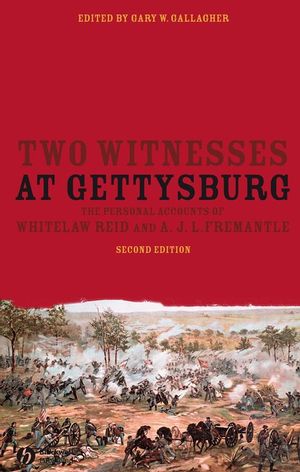
War journalism is not something I’ve read/written about before but I am killing two literary birds with one stone by analyzing an account of the Battle of Gettysburg. With an essay based mid-term tomorrow in my journalism class, I hope that writing down my thoughts will prove to be sufficient preparation. Moving on…
Two Witnesses at Gettysburg is, as the title states, composed of two accounts of this battle. Specifically, I read Whitelaw Reid’s perspective . Whitelaw Reid was an American politician and newspaper editor from Ohio. He was working for the Cincinnati Gazette when he was assigned to accompany the Union army and write a report on the Battle of Gettysburg.
To fully appreciate Reid’s story, it is important to have the context of war reporting during his time. Journalism in America during the civil war was in its infancy. Reporters were figuring out what it meant to effectively report on wars. Being influenced by English writers, journalism at the time tended to be ponderous and flowery in style. Additionally, news took a lot longer to reach the general public since many people could not afford to send telegrams. Thus, people were not concerned about the quality of reporting at the time; they were more concerned about hearing any sort of news from the front lines. Reid enters the stage during this time as one of many journalists that were sent out to report on the events of battles as they unfolded. Though there were many journalists present during this war, Reid’s account is the most revered.
Reid himself was a republican, and a Union supporter. Unlike modern journalism which has a neutral tone and focuses on facts relevant to the story, Reid did not hesitate to insert his strong opinions throughout his account and let his bias show. It is first clear that he is a Union supporter by aligning himself with the Union army uses the pronouns “us” and “we.” His bias towards the Union was further strengthened through his primary use of sources: Union generals and officers, as well as other reporters that were associated with the Union. Though he is biased towards the Union, he does not spare them from criticism as well. At one point, he criticizes drunk Union soldiers and stragglers as he is on his way to Gettysburg.
Despite his clear sympathy towards the Union, Reid was still able to capture the full picture of the battle. He laid out what he saw as he saw it, sparing no details. Sometimes, his obsession with detail can veer towards verbosity. The scene at the end of the battle where he picks a flower spotted with the blood of the fallen soldiers is one example of where his style slides from journalism to poetry. While this style was common of war reporters at the time, Reid differs from the norm in that he avoids glamorizing the battle. A common criticism of journalism during his time is that war was glorified. Reid however includes the suffering and pain the soldiers were going through. At the end of his account, he goes on to describe how disappointed he is in the Union army for General Meade not pursuing Lee, even though they did win the battle.
It is clear through Reid’s account that he was an avid reader. His literary style influenced him to not only capture every detail of the actual war, but include small details, such as the blood spotted flower, that stick with the reader. Overall, it is clear why his account is still read and used as an example of journalism during the civil war. While Reid is biased and verbose at times, his report is rich in detail and gives an insight into key aspects of civil war journalism. I would never have picked this book up to read on my own, but those who enjoy war reporting or are interested in how journalism in the US has evolved over time will find interest in Reid’s account.
Rating: 3.5 out of 5 stars
